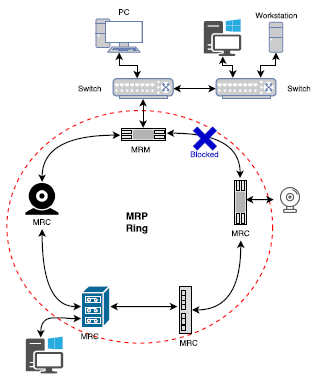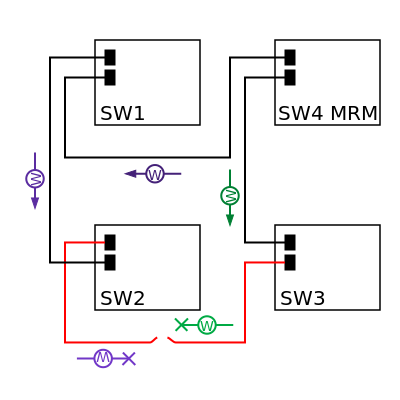Media Redundancy Protocol (MRP) is a recovery protocol based on a ring topology. MRP allows rings of Ethernet switches to overcome any single failure with recovery time much faster than achievable with traditional alternatives like Spanning Tree Protocol. MRP is not able to offer zero-delay recovery time like HSR or PRP, but it is suitable to most Industrial Ethernet applications and it is quite popular in some sectors.

MRP Nodes
In MRP, there are two kind of nodes, the Media Redundancy Manager (MRM) and the Media Redundancy Clients (MRC).
Media Redundancy Manager (MRM)
One of the nodes in a MRP network has to be a Media Redundancy Manager (MRM). The function of the MRM is to observe and control the ring topology in order to reach on network failures.
The MRM node controls the ring state by performing the following functions:
- Sending MRP Test frames at a configured time period in both directions of the ring.
- Setting one ring port to FORWARDING state and the other ring port to BLOCKED state if it receives its own MRP Test frames.
- Setting both ring ports to FORWARDING state if it does not receive its own MRP Test frames on both ring ports within a configured time according to MRP TSTdefaultT, MRP TSTshortT and MRP TSTNRmax.
Media Redundancy Client (MRC)
Nodes in a MRP ring that do not act as the ring managers have the role of Media Redundancy Clients (MRC). These nodes react on received recon guration frames from the MRM and can detect and signal link changes on its ring ports.
The MRC node performs the following functions:
- Detects a failure or recovery of a ring port link and notifies the change by sending MRP LinkChange frames through both of its ring ports.
- Processes the MRP TopologyChange frames and clears its FDB if requested by an MRP TopologyChange frame in a given time interval MRP Interval.
- Forwards MRP Test frames, MRP TopologyChange frames, MRP LinkChange, MRP InTest frames, MRP InLinkChange frames, MRP InTopologyChange frames and MRP InLinkStatusPoll frames between its ring ports only.
- Ring ports can take one of the following port states:
- BLOCKED: all frames are dropped except the MRP frames.
- FORWARDING: all frames are passed through according to the forwarding rules.

Photo: MRP in Ring open-status. Credits: Biezl under CC BY 3.0
SoC-e MRP Technology
SoC-e Ethernet Switch IP Cores support Media Redundancy Protocol (MRP). SoC-e’s switch IP Cores support both roles of MRP: client (Media Redundancy Client – MRC) or manager (Media Redundancy Manager – MRM). These mode of operation are fully implemented on hardware, and there is no need for MRP software stack.
SoC-e provides technology to integrate these functionalities in the following product:
